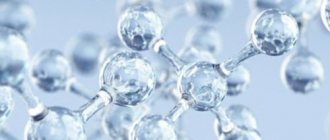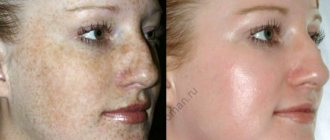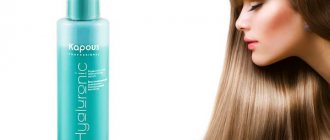How a lack of hyaluronic acid leads to skin aging -
Almost all of the skin's hyaluronic acid is located in its dermal layer (Fig. 2) - exactly where the collagen and elastin fibers responsible for skin elasticity are located. Loss of moisture (dehydration) from this layer of skin leads to the following effects:
- Slow collagen degeneration - a decrease in the amount of hyaluronic acid leads to a decrease in water content in the dermis, which leads to weak hydration of collagen and elastin fibers with water. Under these conditions, slow degeneration of collagen fibers occurs with a gradual decrease in its quantity. In addition, all other collagen loses the proper degree of plasticity (ability to shrink/decompress). And this affects the elasticity of the skin.
- Reduced skin thickness – dehydration of the dermal layer of the skin leads to a decrease in its thickness, accordingly, the skin becomes thinner and less elastic. Thin skin is more prone to the early appearance of wrinkles.
- Reduced activity of fibroblasts and keratinocytes - fibroblasts are responsible for the synthesis of collagen and elastin. When there is a lack of hyaluronic acid, their activity decreases, which affects their collagen production. The activity of keratinocytes, on which the thickness of the epidermal layer of the skin depends, also decreases. A decrease in the thickness of the epidermis leads to a decrease in the protective properties of the skin and to greater evaporation of water from its surface.
Hyaluronic acid for the face: reviews from cosmetologists... thus, the additional supply of hyaluronic acid (with a decrease in its content in the dermis) helps ensure that the dermis is saturated with moisture and the collagen remains sufficiently hydrated with water. Plus, the activity of fibroblasts and keratinocytes increases, stimulates angiogenesis, cell regeneration, and metabolic processes. All this keeps the skin well hydrated, elastic and, accordingly, prevents the development of wrinkles.
Why don’t all external products with hyaluronic acid work?
Hyaluronic acid belongs to the class of polysaccharides, or more precisely glycosaminoglycans. It consists of repeating fragments (Fig. 3), which are usually called disaccharide units. Normally, one hyaluronic acid molecule contains up to 25 thousand of these repeating fragments. As a result, the molecule is a ribbon (Fig. 4), which is rolled into a loose tangled ball.
Hyaluronic acid molecules are large in size and molecular weight, and therefore they normally do not penetrate the skin - deeper than the cracks between dead epidermal cells. Therefore, some manufacturers use low molecular weight hyaluronic acid in their creams and serums, which has been artificially reduced to a size that allows it to penetrate the skin well.
Therefore, the size of HA molecules in skin products is very important! The size (mass) of hyaluronic acid molecules is measured in daltons (Da). A standard hyaluronic acid molecule has a mass of up to 25,000,000 Da. In some sources you may find mass notation in the form of kDa (kilo Dalton). So, for example, 25,000,000 Dalton = 25,000 kDa).
Low molecular weight hyaluronic acid –
Low molecular weight molecules are considered to be hyaluronic acid molecules with a chain size of less than 130,000 Daltons. Such molecules penetrate the difficult skin barrier much more easily. Having penetrated the dermal layer of the skin, such molecules absorb water from the inside (which penetrates the dermis through the walls of blood vessels). By binding and holding it, they saturate the dermis with moisture.
But even low molecular weight HA is heterogeneous. Different size chains have completely different effects. Therefore, the best manufacturers use low molecular weight HA in their products not of one size, but of different sizes...
- Chains weighing from 400 to 10,000 Daltons - they most contribute to angiogenesis, i.e. the appearance of many microvessels in the dermis. This leads to better blood supply to the skin, which means better saturation of it with oxygen, nutrients, and activation of metabolic processes in the skin.
- Chains weighing from 50,000 to 130,000 Daltons - this size of molecules leads to good saturation of the dermis with moisture, but this size of chains especially stimulates cell proliferation and migration, increases the activity of fibroblasts + the production of new collagen. The activity of keratinocytes also increases, which helps to increase the thickness of the epidermis and increase its hydrophobic properties (i.e., the thicker the epidermis, the less moisture will evaporate from the surface of the skin).
Important : studies have shown that HA chains weighing up to 1 million Daltons can pass through the skin. However, the same studies showed that HA chains weighing from 500,000 to 1,000,000 Daltons (they are already considered high molecular weight) partially cause the opposite effects. Although they saturate the dermis with moisture, they also suppress the proliferation of fibroblasts, collagen synthesis, and angiogenesis (24stoma.ru).
High molecular weight hyaluronic acid –
Molecules of hyaluronic acid with a chain size greater than 130,000 Daltons are considered high molecular weight. But that doesn't mean they don't work. High molecular weight hyaluronic acid forms a thin gel-like “polymer” film on the surface of the skin, which begins to very quickly absorb moisture from the air.
The formation of a gel-like film leads to the following effects:
- an increase in water content in the epidermal layer of the skin,
- an additional barrier appears for the evaporation of moisture from the skin surface,
- The polymer film allows the biologically active components included in the cosmetic product to contact the skin longer and more closely, which increases their absorption.
Important : the greater the molecular weight of the hyaluronic acid used (we remind you that its maximum weight = 25,000,000 Daltons), the higher the effectiveness and duration of action of such a gel-like film.
CONCLUSIONS on choosing skin products -
Thus, HA molecules of different masses work completely differently. This can influence the choice of skin care products, depending on what you expect from using such products.
- Products with low molecular weight hyaluronic acid will work from the inside, penetrating the dermal layer of the skin, increasing its water content, which leads to an increase in the degree of hydration of collagen and elastin and an increase in their elasticity.
They also activate the function of fibroblasts and keratinocytes, increase collagen production, increase metabolic processes in the skin, and stimulate angiogenesis. Studies have shown that products with HA molecules from 50,000 to 130,000 Daltons are better than others in helping to restore skin elasticity. Just keep in mind that HA molecules are destroyed in the body over time: from less than a day to 2 days. Therefore, these products must be used constantly, otherwise you will slip back to the original skin condition. Moreover, the smaller the size of HA molecules, the faster they are destroyed by macrophages.
- Products with high molecular weight hyaluronic acid - the size of the HA molecules in such products should be at least 1,000,000 Daltons (and this is the worst option).
In the best case, the molecules should have a maximum size, i.e. approaching 25,000,000 Daltons. Keep in mind that such products can, on the contrary, dry out your skin if the surrounding air is not sufficiently humidified, i.e. dry In this case, the gel-like film will tend to absorb water even from the surface layer of the skin. These products allow you to quickly moisturize and improve the condition of the most superficial layer of skin (epidermis). You shouldn’t count on an increase in moisture in the dermis and an increase in skin elasticity. The effectiveness of such products will be much higher if, in addition to HA, they contain ceramides (unsaturated fatty acids), which also prevent the evaporation of moisture from the surface of the skin.
List of inexpensive products
Among the inexpensive eye moisturizers, the following are preferred:
- Hyphenation . The drug forms a strong tear film and does not distort vision, and also has a moisturizing effect. It has the longest contact with the cornea, as it contains the viscous component hypromellose. It is not recommended to use this product without breaks for more than three weeks. Every day you can do no more than eight drops (two drops in each eye).
- Slesin. One of the most “neutral” drugs that can be used for moisturizing at any age. In addition to dry eye syndrome, the drug is prescribed as a prophylactic solution for lacrimation disorders resulting from ophthalmological diseases or injuries. Depending on the need, it is instilled every 3-5 hours.
Hyaluronic acid in cosmetology –
Why is hyaluronic acid attractive in cosmetology, and what are its benefits? In addition to external agents, there are injection forms of administration, which can be aimed either at a general improvement in the condition of the skin or at smoothing out wrinkles.
Deep hydration of the skin of the face and neck –
The method of skin rejuvenation with injections of hyaluronic acid is called biorevitalization (from the words - renewal, revitalization). The hyaluronic acid solution is administered intradermally using multiple microinjections using a special automatic injector or syringe (Fig. 5-7). Solutions for biorevitalization can also contain all kinds of vitamins and amino acids.
Hyaluronic acid: reviews of biorevitalization techniques... we have already written similarly about the results of clinical studies of skin biorevitalization. Today this technique is quite controversial. If an increase in the production of collagen and elastin after injections of hyaluronic acid occurred (only in one study), it was still only at the level of statistical error. But in general, patients noted that the skin looked more rested after the injections for about a month.
Original photos from a study on the effectiveness of biorevitalization, taken before and after (can you see the difference?)
What explains the slight increase in collagen levels - it must be said that this method is carried out using a series of numerous micro-injections, which lead to numerous small injuries to the skin with a needle. The skin instantly reacts to any damage by activating regenerative mechanisms, including collagen production, activation of angiogenesis and blood supply. In our opinion, the improvement in skin condition with this technique occurs precisely because of the punctures of the skin, and not due to the contents of the syringe.
By the way, this is also proven by the fact that in one of the studies ( read the study ) an uneven increase in collagen was found, precisely in the places where the skin was punctured with a syringe needle. Considering that the hyaluronic acid solution spreads throughout the tissues upon injection, it is quite strange that the increase occurred only at the points where the needle was inserted into the skin.
By the way, look how the condition of the skin improves when exposed to a fractional laser, when using darsonvalization (discharges leave pockets of micronecrosis in the skin, which stimulate skin regeneration). Or like after using badyagi, which injures the skin with microneedles - after 2 days the skin tone becomes much healthier and even. All this proves our point.
Undoubtedly, the contents of the syringe affect metabolic processes to some extent, but this effect is extremely small and short-lived. In addition to injections, there is also hyaluronic acid in tablets, creams with sodium hyaluronate or hyaluronic acid (read about them below).
Smoothing wrinkles, adding volume to lips, cheekbones –
In cosmetology, hyaluronic acid is also used as a basis for fillers (dermal fillers), which are intended to correct wrinkles, or to increase the volume of lips or cheekbones. Hyaluronic acid fillers are a gel that is injected subcutaneously with a syringe. The gel has the property of not dissolving for a long time (up to 1 year), which achieves the lifting effect.
The principle of smoothing wrinkles with fillers with hyaluronic acid –
The effect of using fillers is visible immediately after the procedure. But you need to take into account that smoothing wrinkles or increasing the volume of cheekbones or lips will be temporary, because... The gel tends to slowly dissolve in the body. On average, the effect lasts for a period of 6-12 months (depending on the brand of filler chosen).
But there are long-acting fillers, the effect of which can last from 2 to 10 years. They are no longer made from hyaluronic acid, but based on suspended calcium hydroxyapatite, poly-L-lactic acid, and polymethyl methacrylate microspheres.
Patient reviews
“When I first
encountered the problem of dry eyes , I experimented for a long time, trying expensive and cheap products. In the end, I decided to settle on a teardrop . This is a natural product that
does not cause for me and allows me to work comfortably at the computer all day . In addition, if necessary, such a product can easily be purchased at any nearby pharmacy, which cannot be said about some expensive and supposedly “more effective” products.”
Anton Leontyev, Volgograd.
“ My daughter is in the eighth grade and due to heavy strain on her eyes during lessons, several months ago she began to get very tired , citing the fact that reading and using the computer cause discomfort.
When visiting an ophthalmologist , it turned out that the girl had dry eye syndrome .
SOLGAR hyaluronic acid tablets: reviews
In the Russian segment of the Internet, Solgar, hyaluronic acid in tablets, is gaining great popularity. The manufacturer claims that taking this drug improves the condition of the joints, penetrating into the interarticular fluid, and also improves the condition of the skin, moisturizes it, fights wrinkles, and so on.
The fact is that hyaluronic acid molecules are too large, and therefore, when taken in tablets, they are not able to be absorbed in the intestines and penetrate into the blood. Accordingly, hyaluronic acid does not penetrate either into the joints or into the skin... The effect can generally only come from either the injectable form or the form for topical use (creams, serums), but not from tablets.
However, some reviews insist that hyaluronic acid in capsules/tablets can be perfectly absorbed in the body and improve its general condition. This is an outright lie, left by paid commentators in forums and thematic blogs, not supported, banally, by either the laws of biochemistry or the laws of human physiology.
Solgar hyaluronic acid: reviews from experts... on the seller’s website page you will, of course, see only positive reviews. Everything about the quality of these reviews is already clear, given that hyaluronic acid is not absorbed at all in the intestines. However, Solgar hyaluronic acid capsules also contain a large dose of vitamin C (as much as 167% of the daily dose in one capsule), which is absorbed in the intestines.
Vitamin C is a good antioxidant and immunomodulator, and of course can improve the general condition of the body. It is clear that if a stimulating effect occurs, it is only due to the presence of this vitamin. For information, Solgar hyaluronic acid price will range from 1200 to 2300 rubles (for 30 capsules). Isn't that a lot for vitamin C alone?
Even if you try (even if you spend a year), you will not find a single clinical study that has been conducted on the effectiveness of oral administration of hyaluronic acid in tablets or capsules. Of course, it is absolutely harmless, but taking it in tablets is absolutely pointless.
Hyaluronic acid injections –
There are two types of hyaluronic acid injections for skin rejuvenation. In the first case, a solution of hyaluronic acid is used, which quickly dissolves when administered intradermally. In the second case, hyaluronic acid gel is used, which does not dissolve in tissues for a long time. These two forms of application have completely different properties and effects...
- Use of hyaluronic acid solutions – injections of hyaluronic acid in this case can improve the appearance of the skin, giving it a rested, radiant appearance by deeply moisturizing the skin (at least that’s what the manufacturers say). But these injections will not reduce the depth of wrinkles.
This skin rejuvenation is usually called mesotherapy or skin biorevitalization. Essentially, these are synonyms. The term “mesotherapy” should simply be understood as a method of administering medicinal substances intradermally. But the second term began to be used in cases where mesotherapy is carried out specifically on the face. A beautiful term “biorevitalization” was coined for this purpose.The most popular HA preparations for deep moisturizing facial skin are:
Injections of hyaluronic acid: reviews, many consider biorevitalization of the skin with injections of hyaluronic acid to be a hoax. Most independent clinical studies have shown that there is practically no stimulation of the synthesis of collagen and elastin in the skin (the increase in their content fluctuates at the level of statistical error). However, some patients note that the skin looks more rested after such injections.
- Using gels with hyaluronic acid (fillers) – such gels are excellent at dealing with deep wrinkles and folds, reducing their depth. This method is often called facial contouring, because... Hyaluronic acid gel injected intradermally not only smoothes out wrinkles, but also helps give additional volume to the cheekbones, chin, and enlarges the lips.
The most popular fillers based on hyaluronic acid: → “Juvederm®”, → “Restyline®” (Fig. 19).The effect of using fillers is immediate and lasts about a year. Hyaluronic acid injections - reviews from all patients confirm the effectiveness and safety of this method of skin rejuvenation. The only downside can be the cost of the procedure, where the price is calculated depending on the volume of the injected gel. Fillers are the most popular anti-wrinkle treatment in the US and Europe, along with Botox® injections, which are excellent for treating fine lines and wrinkles.
Hyaluronic acid injections: reviews, price
Hyaluronic acid injection - the price is calculated based on the amount of the drug in ml that is injected into the tissue. This also applies to hyaluronic acid solutions for biorevitalization and fillers for wrinkle correction (hyaluronic acid in gel form).
| Cost of the biorevitalization procedure | Price, rub |
| Restylane Vital – 1.0 ml Restylane Vital (injector) – 2.0 ml | 11000 17000 |
| Restylane Vital Light – 1.0 ml Restylane Vital Light (injector) – 2.0 ml | 10000 16000 |
| Juvederm Hydrate – 1.0 ml | 11000 |
| IAL-System – 1.1 ml | 8500 |
| Facial contouring with fillers | Price, rub |
| Restylane gel – 1.0 ml | from 15000 |
| Perlane gel – 1.0 ml | from 17000 |
| Restylane Lip Volume gel – 1.0 ml | from 18000 |
Types of hyaluronic acid
There are many products containing hyaluronate, produced by different manufacturers and intended for different purposes. Only a specialist can determine which drug to use in a given situation, taking into account his own clinical experience, the properties of the drug and the individual characteristics of the patient.
In general, all drugs can be divided into several groups.
According to the molecular chains of hyaluronic acid:
- Low molecular weight hyaluronate - has anti-inflammatory properties, penetrates the cell barrier well, penetrates into the deep layers of the skin, stimulates tissue metabolism, and quickly disintegrates. Low molecular weight hyaluronic acid does not have a moisturizing effect because its molecules are too small to retain water, but they are excellent at transporting the necessary elements very deep into the tissue.
- Medium molecular hyaluronate - improves the regeneration process, usually used in the treatment of arthritis or in ophthalmic surgery.
- High molecular weight hyaluronic acid - disintegrates very slowly, stimulates all cellular processes and promotes fluid retention in tissues, which provides a pronounced moisturizing and rejuvenating effect. This is what is used in contour plastic surgery.
Stabilizers or crosslinkers
Crosslinkers, a term used by manufacturers, refer to substances that have been used to stabilize hyaluronate molecules by forming cross-links between them. Stabilization of hyaluronic acid molecules ensures a slower degradation of hyaluronate.
Hyaluronic acid used in cosmetology can be:
- stabilized (modified) - used in contour plastic surgery;
- unstabilized (native) - intended for mesotherapy or biorevitalization.
Different manufacturers use a variety of substances as stabilizers. Thus, in the production of Restylane, Juvederm and Belotero, the stabilizer 1,4-butanediol diglyceride ether (BDDE) is used; Prevelle Silk, Captique and Hylaform contain divinyl sulfone (DVS), while Prevelle Dura uses 1,2,7,8-diepoxyoctane ( diepoxyoctane - DEO), known as a "double binder" substance.
However, the above stabilizing agents may cause an allergic reaction and may also be toxic to the body. BDDE has the least toxicity. NEAUVIA ORGANIC has created a new generation of hyaluronic acid preparations using polyethylene glycol (PEG) as a cross-linker, which is 30 times safer than BDDE, reduces the risk of developing an immune response to the drug and suppresses the action of hyaluronidase (a group of enzymes in the human body that breaks down hyaluronate).
Preparations based on hyaluronic acid
Depending on the type of hyaluronic acid, there are several types of preparations made on its basis and used in cosmetology:
- Bioremedies - contain hyaluron, vitamins, micro- and macroelements, as well as bioactive substances, stimulate the process of synthesis of its own hyaluronic acid.
- Biorevitalizants - contain high molecular weight hyaluronic acid, stimulate the synthesis of elastin and collagen fibers.
- Mesotherapy cocktails are products that, in addition to hyaluron, also contain vitamins, peptides, lipolytics, coenzymes and various extracts.
- Fillers are preparations for correcting facial contours, cheekbone lines, lip contouring, and smoothing wrinkles. Fillers can be made based on hyaluron (Restylane, Juvederm, Stylege, Teosyal, Surgiderm) and other substances (Ellan based on polycaprolactone, Sculptra based on polylactic acid, Radiesse based on calcium hydroxyapatite). All fillers differ in concentration, cohesiveness (the ability of the drug to maintain its shape, not spread or dissolve) and elasticity, which is indicated by the G' value. Drugs with high G' are used to correct local defects, for example, eliminating the nasolabial fold, raising the tip of the nose or the lateral part of the eyebrows. Preparations with lower G' are used to correct large areas (cheekbones, lips, cheeks, etc.).
In medicine, two types of hyaluronic acid are used: animal origin and synthetic, which is fermented from specially grown microorganisms. The latter is considered the standard of modern cosmetology; it cannot become a source of infection or lead to the development of allergies.
Cream with hyaluronic acid: reviews, how to choose
Many consumers know what an excellent moisturizing effect hyaluronic acid has, and therefore they look for this particular ingredient in creams.
More and more brands are advertising hyaluronic acid in their creams, but if you read their ingredients on the label, it turns out that they are listed at the very bottom of the list. This means that the proportion of hyaluronic acid there is extremely small. Recommended concentrations of hyaluronic acid –
- conventional skin care products 0.05-0.4%,
- highly moisturizing products and anti-aging cosmetics – 0.5-1.5%.
Do not buy products with hyaluronic acid where the percentage of its content is not indicated! In addition, it should be indicated whether the product contains hyaluronic acid itself, or its salt – sodium hyaluronate.
Recommended sizes of HA molecules in skin products - ideally, if the manufacturer indicates the molecular weight of hyaluronic acid molecules in the composition of their product. Some (without quantitative indicators), which does not inspire confidence. Serums should only be made from low molecular weight HA with a molecular size of up to 130,000 Daltons.
In cream products, the choice of HA molecular size will depend on what effects you are expecting -
- If you are more interested in increasing skin elasticity, then in this case the size and mass of HA molecules should be from 50,000 to 130,000 Daltons.
- If there is a rapid obvious improvement in the hydration and appearance of only the upper layer of the skin, then the mass of HA molecules should be as large as possible, but not less than 1,000,000 Daltons. We described in detail why this is so at the beginning of the article. And, by the way, such funds will be much cheaper than the first ones.
- There are products that contain a combination of both low molecular weight and high molecular weight HA. This option will probably be preferable.
Attention to additional components - it is better to refrain from creams that contain: fragrances, alcohol, natural oil essences (they reduce the effect or destroy hyaluronic acid molecules). But vitamins C, E and B5, on the contrary, enhance its effect, and therefore it is very good if they are included in the cream. It is very good if the cream contains ceramides (unsaturated fatty acids), which also greatly moisturize the epidermis and prevent the evaporation of moisture from the surface of the skin.
Is it possible to add a solution of hyaluronic acid from ampoules to a regular cream?
If you find an excellent moisturizer that suits your skin, but it does not contain hyaluronic acid, you can buy it at the pharmacy in the form of ampoules and simply add it to your cream. In this case, hyaluronic acid will have a large mass of molecules and will not penetrate the skin. But, as we have already said: working on the surface of the skin, it forms a gel-like polymer film.
This protective film remains on the skin for a long time; after application, it begins to absorb water from the air, which leads: firstly, to the saturation of the surface layer of the skin with moisture, and secondly, to protection against moisture evaporation from the surface of the skin. Those. as we see, creams with both high and low molecular weight hyaluronic acid will work to moisturize the skin. They will just do it in different ways, and to different depths.
The mechanism of action of low molecular weight hyaluronic acid is completely different. Penetrating into the dermis, they absorb water there (coming from blood vessels), which leads to an increase in the moisture content in the dermal layer of the skin, and also affects fibroblasts, collagen, etc. there.
Hyaluronic acid or sodium hyaluronate in cream: which is better?
Sometimes you can read in the composition that the cream does not contain hyaluronic acid, but sodium hyaluronate. This may not be clear, so it requires a little clarification. Chemically, sodium hyaluronate is a salt derived from hyaluronic acid. It has a number of advantages over hyaluronic acid itself, although both of these components have good moisture-retaining properties.
The main difference between sodium hyaluronate is its molecular size. During the process of creating sodium hyaluronate, its molecular weight is reduced by removing lipids and nucleic acids, making the molecule much smaller than hyaluronic acid. This means that when applied topically, sodium hyaluronate molecules penetrate the skin more easily.
Hyaluronic acid – how to choose?
When choosing hyaluronic acid, the rule usually works: the more expensive the product, the better it is. Of course, this is a simplified approach, but it can certainly be assumed that more expensive acids have a better purification and cross-linking process.
It is worth explaining that the division of hyaluronic acid into non-cross-linked, slightly cross-linked and highly cross-linked acid is sufficient for choosing a drug. Any other options, for example, HA for the area around the eyes or for filling wrinkles, are a marketing ploy. The doctor chooses the remedy precisely according to the density’s compliance with the goals set.
The drug must be certified because it is a medical item, just like a dental implant, a knee implant, or a breast implant. If there is no certificate, it means it is not hyaluronic acid, but who knows what.
An important indicator of the quality of hyaluronic acid are parameters indicating the degree of its purification, that is, the degree of removal of the cell walls of acid-forming bacteria. This is important because excess elements can cause allergic reactions. Parameters indicating how much bacterial debris remains in the acid should be found in the instructions or on the manufacturers’ website. Preparations can vary in degree of purification by up to ten times. The general rule is to choose drugs with bacterial residue levels below 10 U.
It is important to know how much cross-linking agent is in the preparation. This information is difficult to find, but it can determine the presence of complications. Doctors who practice procedures with hyaluronic acid already know in practice what to expect from a particular brand. For example, a drug may contain up to 9% BDDE, while other acids contain much less of this substance. More chemical products work longer, but using them in very visible areas is risky.
Finally, it should be remembered that since HA, despite its biocompatibility, is a foreign body, therefore not everyone can use it. To avoid complications, you need to choose the right drug, prepare for the procedure and take into account all contraindications and restrictions.
What is possible and what is impossible to achieve with creams -
There is a lot of deception on the Internet. Entire companies with paid commentators leave laudatory reviews every day about the products they promote, and at the same time scold their competitors. Some useful tips...
Creams with HA will never smooth out wrinkles
Not a single cream with hyaluronic acid can cope with pronounced wrinkles, folds, sagging and other signs of skin aging, no matter how cream manufacturers promise it. For example, it promises that using its gel, wrinkles will be filled in and smoothed out. Unfortunately, this is simply impossible!
Also, do not be fooled by advertising articles that promise you a reduction in wrinkles, and by rave reviews from paid commentators on various forums and blogs (in fact, 99% of reviews on forums on the Internet are hidden advertising). All these creams can do is basically moisturize your skin and give it a more rested look, slightly reduce by 15-30% the depth of the smallest wrinkles (for example, around the eyes or on the upper lip).
If you constantly use high-quality products with low molecular weight HA, you can expect an increase in skin thickness and elasticity. But keep in mind that as soon as you stop using these products, you quickly return to your original skin condition.
Price matters -
The production of low molecular weight HA is a very expensive process. Effective, high-quality products with high concentrations of low molecular weight HA a priori cannot be sold for 500-1000 rubles. Usually their cost ranges from 4,000 to 8,000 rubles. If you want to buy a quality product, be prepared that it will be expensive (although a 30 ml serum with HA may last you 3-4 months of daily use).
What creams and serums with hyaluronic acid can be recommended -
It is most optimal to use serums, because... they are more efficient. If you have dry skin, then use a cream with HA, or a serum under the cream.
The best serums with hyaluronic acid –
- SkinCeuticals® “Hydrating B5 gel” (USA) –
This serum contains 0.5% low molecular weight HA, vitamin B5, as well as a moisturizing complex of pyroglutamic acid, urea, trehalose and polyquartenium-51. You can buy it in the company's Russian online store SkinCeuticals®. Cost (30 ml) – about 4700 rubles. Designed more to prevent age-related changes. - SkinCeuticals® “HA Intensifier” (USA) –
This serum contains 1.5% hyaluronic acid, 2% dipotassium cittirisate, 10% proxylane. Designed to correct age-related skin changes. Cost about 8,000 rubles (30 ml). You can buy it in the company's Russian online store SkinCeuticals®. - Serum “Tete” (Switzerland) –
cost from 2200 rubles per package with three bottles of 10 ml each. The manufacturer does not disclose the concentration of HA, but the products of this company have always been of high quality (for example, it was Tete that developed the so-called liposomal cosmetics).
Creams with hyaluronic acid –
As for creams with low molecular weight HA, very few of them are sold in Russia. Only a few brands can be called worthy of at least some trust. Firstly, this is the TETE® liposomal lifting cream, which uses an innovative liposomal mechanism for transferring HA molecules into the skin. Firstly, these are cosmetic products from the French company La Roche-Posay®, which are very widely represented in pharmacy chains.
Important: the most effective option would still be to use not creams, but serums with HA. But keep in mind that immediately after applying and absorbing the serum, you must immediately apply a good cream on top (ideally if it contains ceramides).
Moisturizing drops for adults
For adult patients, the following eye moisturizers can be recommended:
- Cationorm. Developed in Japan and currently a unique cationic emulsion for moisturizing the eyes, it restores all three layers of the tear film, permanently eliminating severe, intense discomfort and dry eyes that appear throughout the day, even in the morning. The emulsion prevents the further development of dry eye syndrome and does not contain preservatives; it can be used in conjunction with contact lenses. Prescribed to people with severe complaints of dryness and eye discomfort; people who wear contact lenses constantly and more than 10 hours a day; people with eye diseases such as glaucoma, blepharitis, allergic conjunctivitis; people undergoing hormone replacement therapy (menopausal hormones, oral contraceptives).
- Oftagel. The best eye gel with carbomer in maximum concentration. Helps with watery eyes, fatigue, itching and burning eyes. The gel can be used once a day, for example, before bedtime; it is perfect for those who do not want or cannot use drops during the day.
- Visine. Despite the fact that side effects often occur when using this drug, Visine remains the most popular drug due to its availability. The drug eliminates the feeling of dryness and “sand” in the eyes, and you do not need a prescription from a specialist to purchase it. It is recommended to instill the drug no more than three times a day at equal intervals, one or two drops in each eye. But if the medicine is prescribed by an ophthalmologist, you must adhere to the regimen prescribed by him.
- Visomitin. An almost complete analogue of Vizine, which is prescribed in case of side effects when using Vizine. Sometimes this medicine is used as an additional remedy in the treatment of cataracts and conjunctivitis of various origins. The solution is instilled three times a day, one drop at a time.
- Systane ultra. A remedy to relieve symptoms of fatigue, irritation and dry eyes. The medicine contains not only moisturizing substances, but also vitamins that strengthen the tissue of the eyeball. There are no strict restrictions in terms of the number of instillations of this product - it can be instilled throughout the day as the feeling of eye fatigue increases, a couple of drops at a time.
- Natural tear . A synthetic drug that is a complete analogue of tear fluid. It can be used not only for adults, but also for children, although in the second case a preliminary consultation with an ophthalmologist is recommended. Approximately every two to three hours, one drop is instilled into each eye.
- Inoxa. The drug not only moisturizes and protects the conjunctiva, but also has a weak antihistamine effect, so it is sometimes prescribed for the complex treatment of eye allergies. If used solely for moisturizing, instill inox as needed. In all other cases, consultation with a doctor is required.
Hyaluronic acid: contraindications
Hyaluronic acid is ABSOLUTELY SAFE both when applied to the skin and when injected. It is safe even when taken orally, because... It’s just not absorbed in the intestines. Rarely, hyaluronic acid can cause allergic reactions. Special precautions include hyaluronic acid injections during pregnancy or breastfeeding.
There is not enough evidence and studies conducted to prove the complete safety of hyaluronic acid during pregnancy. Also, doctors do not know how it affects breast milk and the infant during feeding, so it is recommended not to take risks and refrain from using it. We hope that our article on the topic: Solgar hyaluronic acid buy in a pharmacy reviews was useful to you!







